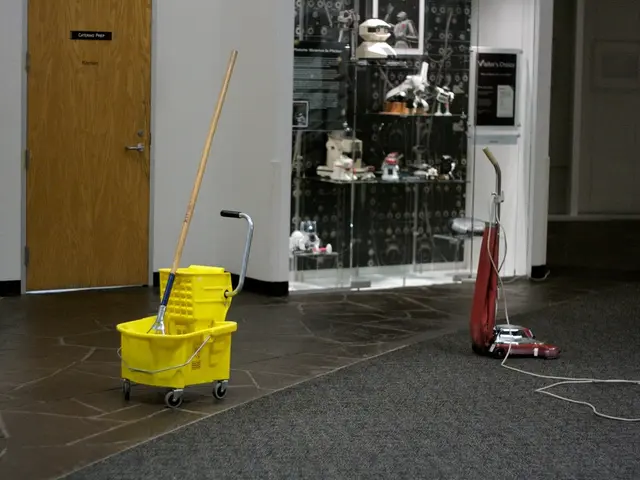Launching a Bubble Tea Enterprise: A Comprehensive Blueprint for 2023
In the ever-growing world of food and beverage, the bubble tea market is one that continues to captivate entrepreneurs. As the market expands, so does the opportunity for success, provided one follows a strategic approach. Here's a comprehensive guide to starting a thriving bubble tea business in 2023.
First and foremost, understanding the market is crucial. Research the size and growth projections of the bubble tea market, such as Australia's expected growth from AUD 94.5 million in 2024 to AUD 169.6 million by 2030, with fruit flavours being particularly popular among consumers.
Next, decide on your business model. Franchising offers advantages like brand recognition, proven operational systems, and supplier networks, significantly reducing startup risks. Alternatively, independent shops provide more creative freedom in branding and menu, but require a deeper understanding of the market and operations.
Developing a business plan is essential. Include detailed financial projections, startup costs, pricing strategy, marketing plans, and operational processes. Address location, staffing, suppliers, and inventory management clearly. Consider taking franchising courses or business management classes to improve readiness, especially if pursuing a franchise route.
Choosing your location carefully is vital. Select high foot-traffic areas with your target customers, such as near universities, shopping districts, or trendy neighbourhoods. A welcoming environment for socialising can build loyal customers, as some shops emphasise creating community-centric atmospheres.
Sourcing quality equipment and ingredients is crucial. Acquire essential bubble tea machines and tools optimised to deliver consistent and high-quality drinks. Focus on fresh, customisable, and possibly health-conscious ingredient options like organic teas, plant-based milks, or natural sweeteners, which appeal to modern consumers.
Design a streamlined menu. Offer a focused selection of core drink categories rather than an overwhelming number of choices, making operations easier and improving customer decision-making. Innovate with localised or signature flavours that resonate with your market, e.g., fusion drinks inspired by local tastes.
Marketing and customer engagement are key to success. Use social media and influencer marketing to tap into the bubble tea culture, which is highly visual and popular among younger demographics. Create a comfortable space encouraging customers to stay, socialise, and form emotional connections with your brand.
Prepare for operations by hiring and training a friendly and knowledgeable staff who can build relationships beyond just serving drinks. Establish standard operating procedures for quality control, inventory, and customer service.
Launch with a soft opening to gather initial feedback and iterate on offerings and service. Monitor sales, customer preferences, and operational efficiencies to adapt quickly to trends and demands.
Following these steps will help entrepreneurs tap into the lucrative and rapidly growing bubble tea market with a solid foundation for long-term success. Pricing menu items to account for ingredient costs, preparation time, and customer affordability is essential. Investing in high-quality equipment like commercial-grade blenders, sealing machines, and refrigeration units is crucial.
Assessing the ambiance and atmosphere of the location to ensure it aligns with your brand image is important. Choosing a location with high foot traffic, near schools or colleges, or easily accessible by various modes of transportation is key. Entrepreneurs can unleash creativity by experimenting with various flavour combinations and toppings.
Implementing combo deals or discounts on specific days can boost sales. Prioritising quality by using premium ingredients and top-tier tea leaves is essential. Conducting a competition analysis is necessary when choosing the ideal location for a bubble tea shop.
Creating a menu tailored to your target audience, featuring a variety of flavours and toppings, is vital. Obtaining a business license is recommended if required in your jurisdiction to legitimise your operation. Cultivating a distinct brand identity with a memorable logo, attractive packaging, and consistent branding is crucial.
Embracing technology with online ordering systems or mobile apps for convenience is advisable. The bubble tea industry is experiencing rapid growth with a dedicated and expanding customer base. Understanding regulations and obtaining necessary licenses is critical when starting a bubble tea business.
Regularly reviewing and updating your menu based on customer feedback and industry trends is necessary. Utilising social media, influencer collaborations, local partnerships, loyalty programs, community engagement, and online ordering for marketing and promotion is essential.
Diversifying the menu by adding snacks or desserts can increase revenue streams for an established bubble tea business. Starting a bubble tea business requires a relatively low initial investment compared to many other food and beverage businesses. Carefully balancing affordability with visibility when choosing a location for your bubble tea business is important.
Actively seeking customer feedback and using it to refine offerings and improve customer satisfaction is vital. Comprehensive research on suppliers specialising in bubble tea products is essential for acquiring top-quality ingredients. With these steps in mind, embarking on a successful bubble tea business venture is within reach.
- Entrepreneurs interested in the food-and-drink sector might find opportunities in the expanding bubble tea market, as the Australian market is projected to grow from AUD 94.5 million in 2024 to AUD 169.6 million by 2030, with a preference for fruit flavors.
- To launch a thriving bubble tea business, entrepreneurs should consider the pros and cons of franchising versus independent shops, each offering unique advantages and challenges in terms of brand recognition, creative freedom, and operational systems.
- Alongside a comprehensive business plan detailing financial projections, marketing strategies, and operational processes, entrepreneurs must pay close attention to location selection, focusing on high foot-traffic areas with a target demographic such as universities, shopping districts, or trendy neighborhoods.
- Source quality equipment and ingredients optimized for high-quality bubble tea, prioritizing fresh, customizable, and health-conscious options like organic teas, plant-based milks, or natural sweeteners that align with modern consumer preferences.
- Design a menu focusing on core drink categories to streamline operations and aid customer decision-making, while also experimenting with localized or signature flavors that resonate with the target market.
- Marketing and customer engagement are key to success, leveraging social media, influencer marketing, and promoting a welcoming atmosphere that encourages socializing and emotional connections with the brand, ultimately leading to a loyal customer base.




